Advanced Laminectomy Surgery in Hyderabad, India
PACE Hospitals is recognized as the best hospital for laminectomy surgery in Hyderabad, offering advanced cervical, lumbar, and decompressive laminectomy procedures for patients with spinal stenosis, herniated discs, and other spine-related conditions. Our team of highly skilled spine specialists, including neurosurgeons and orthopedic surgeons, employs minimally invasive techniques to alleviate nerve compression, restore mobility, and promote faster recovery.
With a patient-centric approach, we create personalized treatment plans using the latest state-of-the-art technology, ensuring optimal outcomes and quicker recovery times. At PACE Hospitals, we prioritize patient safety and well-being, providing cutting-edge facilities and advanced medical care to deliver the best spine care in Hyderabad, Telangana, India.
Request an appointment for Laminectomy Surgery
Laminectomy surgery appointment
Why Choose PACE Hospitals for Laminectomy Surgery in Hyderabad, India?
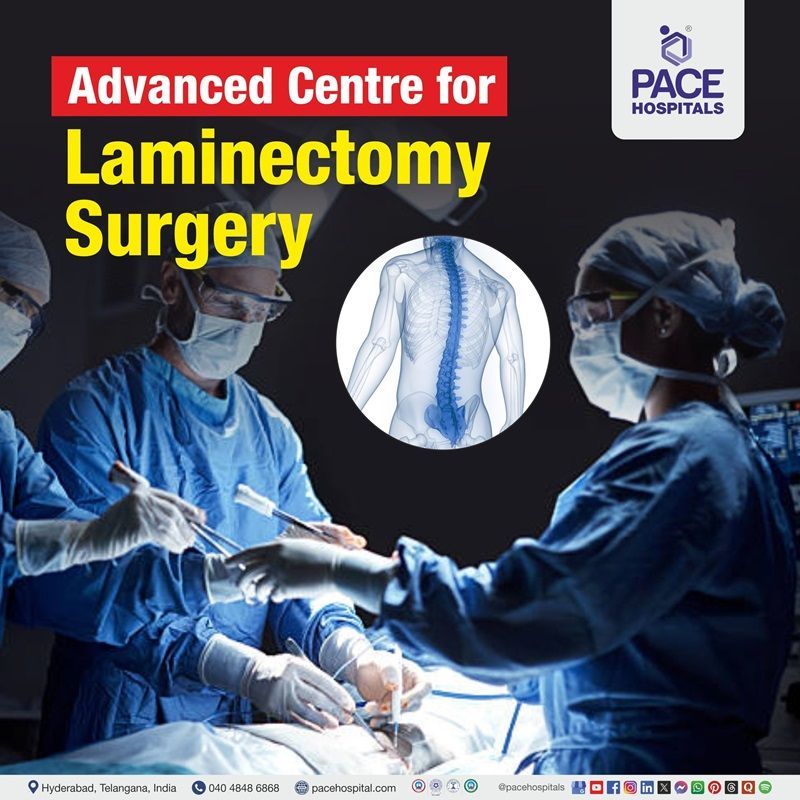
Advanced State-of-the-Art Surgical Techniques
Team of the Best Spine Surgeon in Hyderabad
Precision Laminectomy with 99.9% success rate
Affordable Treatment Costs with insurance and cashless payment
What is Laminectomy Surgery?
Laminectomy definition
Laminectomy is a spinal decompression surgery that removes the lamina (thin bony plate) to relieve pressure on the spinal cord or nerves. The lamina forms the roof of the spinal canal, providing protection and support. By removing excess bone and tissue, this procedure creates more space in the spinal canal, easing nerve pressure, treating herniated discs, spinal stenosis, and tumors.
It is typically recommended for persistent back (lumbar) or neck (cervical) pain unresponsive to non-surgical treatments, especially when accompanied by
weakness, numbness, or loss of bladder/bowel control. Laminectomy is a common procedure in middle-aged and older adults, particularly those over 65.
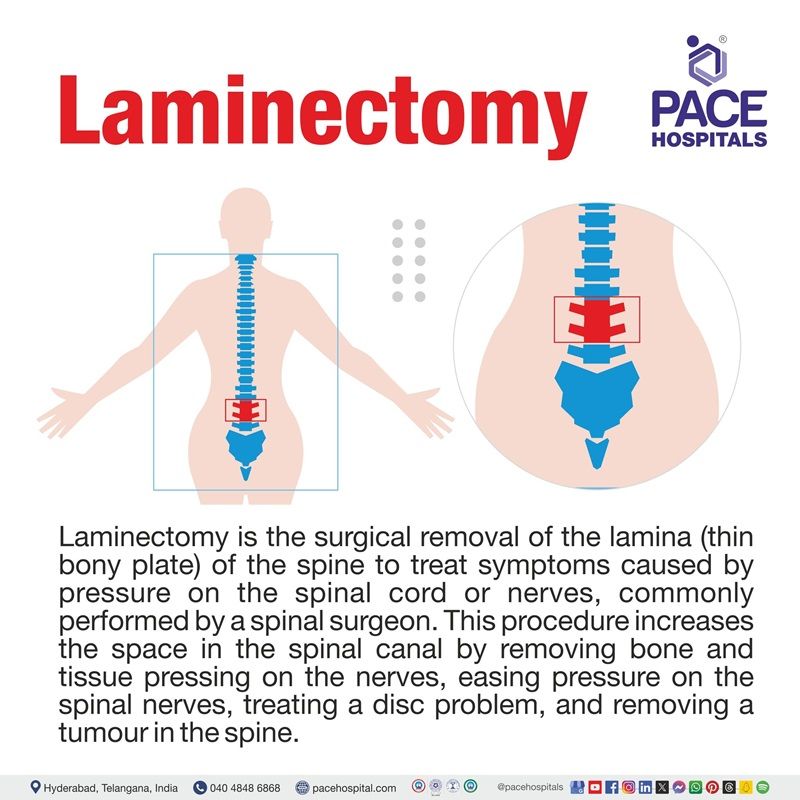
Laminectomy meaning
Laminectomy describes the surgical removal of the lamina. The word "lamina" comes from the Latin "Lamina," which means "thin piece of metal or wood, thin slice, plate, leaf, layer," The word "ectomy" comes from the Greek "ektomia," which means the surgical removal, "a cutting out of."
Spinal decompression
- The spinal decompression method involves different treatment approaches that ease back pain by removing the lamina and other soft tissues to create more space for the nerves, relieving the pressure from the spinal canal. Laminectomy is one such decompression surgery. Depending on the extent of the narrowing, one lamina (single-level) or more (multi-level) may be removed in the process. There are several types of decompression surgery, including:
- Laminectomy: Removal of the entire lamina, a part of enlarged facet joints, and thickened ligaments overlying the spinal cord and nerves.
- Laminotomy: Removal of a tiny portion of lamina and ligaments (commonly) on one side.
- Foraminotomy: Removal of bone around foramen (space between the vertebrae where the nerve root exists the spinal canal)
- Laminoplasty: Spinal canal expansion by cutting the laminae on one side. (performed only in the cervical spine)
Other surgeries, such as discectomy and spinal fusion, may be performed along with the surgeries mentioned earlier if needed based on the patient's condition:
- Discectomy: Removal of damaged disc
- Spinal fusion: Two or more vertebrae are joined together with a bone to strengthen and stabilise the spine. However, in many cases, a combination of these techniques may be preferred.
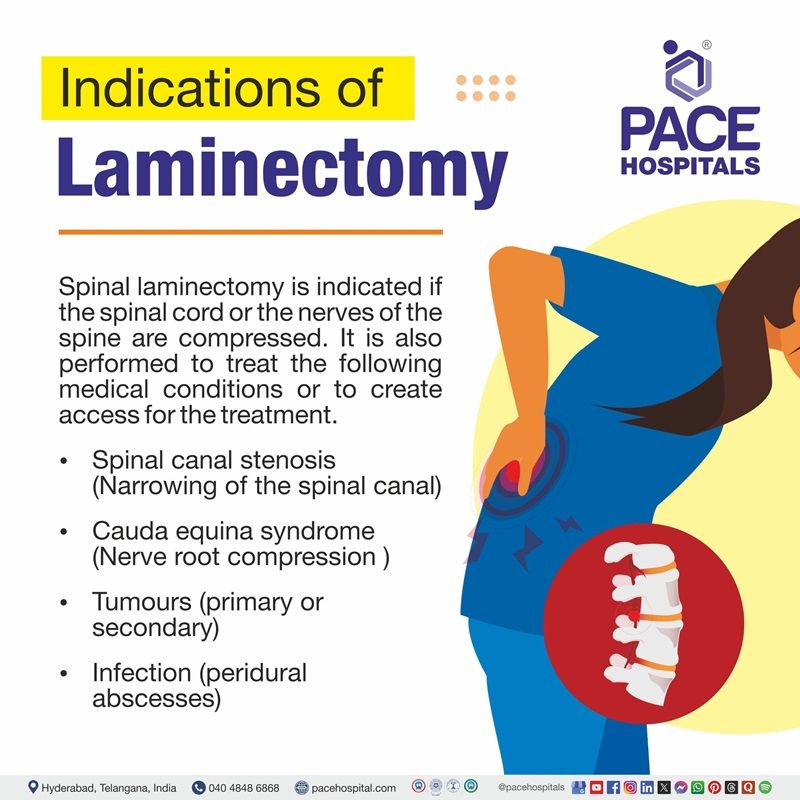
Laminectomy indications
Spinal laminectomy is indicated if the spinal cord or the nerves of the spine are compressed. It is also performed to treat the following medical conditions or to create access for the treatment.
Laminectomy
- Spinal canal stenosis: Narrowing of the spinal canal, not improving despite 12 weeks of medications, injections, and physical therapy
- Neurological deficits: Laminectomy is indicated in people who present with progressive neurological deficits such as numbness, weakness, or intractable pain
- Cauda equina syndrome: It involves compression of the spinal nerve bundle, leading to potential paralysis and loss of bowel or bladder control
- Tumours (primary or secondary): Tumours that are causing narrowing of the canal further
- Infection (peridural abscesses): Infections that are causing narrowing of the canal further
- Trauma: Fractures that compromise the spinal canal
Laminectomy with fusion
Laminectomy operation is often performed alone or together with fusion (joining one or two vertebrae together to prevent instability and movement). It is commonly indicated in the following conditions where the narrowing is caused by abnormal mobility or an abnormal joint between vertebrae (stenosis with spinal instability):
- Degenerative or isthmic spondylolisthesis: One vertebra slips forward over the vertebra below, causing instability
- Kyphosis: Spinal deformity which is characterised by forward curvature of the spine
- Scoliosis: Abnormal sideways curve of the spine
Laminectomy with or without fusion or laminoplasty
Laminoplasty is most commonly performed on the spinal bones in the neck. It should be done with a laminectomy when the surgeon thinks to create more room (space) in the spinal cord (opening up the spinal canal through the lamina).
- Address congenital or acquired stenosis.
- Multilevel spondylosis: This condition refers to spondylotic changes (degenerative conditions) in both the cervical and lumbar regions of the spine.
Types of laminectomy surgeries
There are three different types of laminectomies, which are divided based on the location, such as:
- Cervical laminectomy: The surgeon performs cervical laminectomy surgery on a cervical vertebra in the neck region.
- Lumbar laminectomy: The surgeon performs this procedure on a lumbar vertebra in the lower back region. It is the standard treatment for lumbar spinal stenosis (LSS).
- Sacral laminectomy: The surgeon removes the lamina on the fused sacral vertebrae.
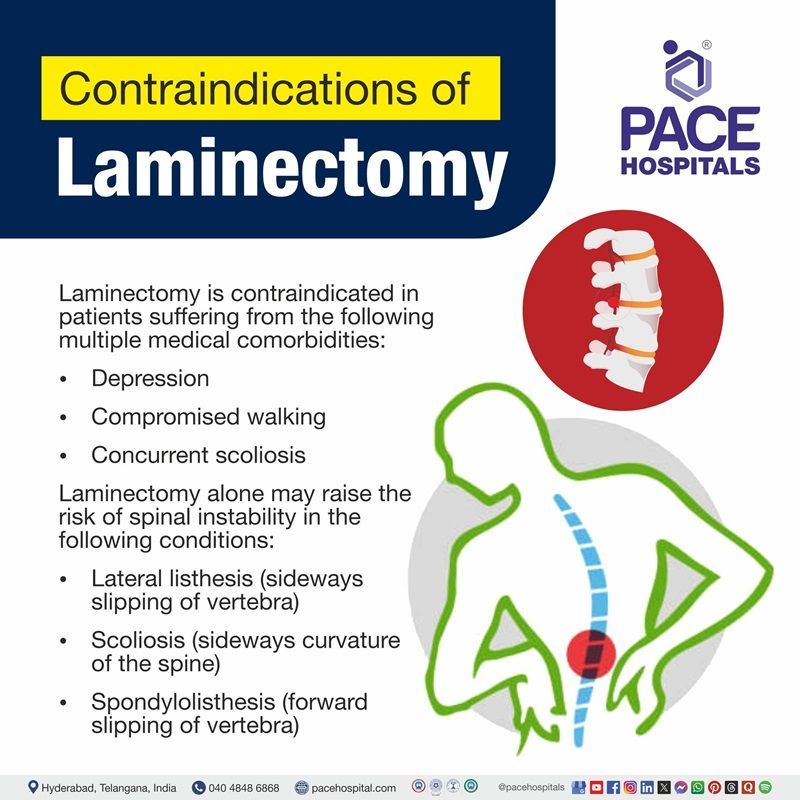
Laminectomy contraindications
Laminectomy alone may raise the risk of spinal instability in the following conditions:
- Lateral listhesis: Sideways displacement of one vertebra on top of another
- Scoliosis: Abnormal sideways curve of the spine
- Spondylolisthesis: One vertebra slips forward over the vertebra below, causing instability
Laminectomy is also contraindicated in patients with the following conditions
- Multiple medical comorbidities
- Depression, compromised walking, and concurrent scoliosis.
Benefits of laminectomy
Laminectomy is one of the decompression methods; surgeons may choose this method to address various conditions over other spine surgeries based on the patient's condition. The following are the typical advantages of laminectomy:
- Relieves pressure (decompression)
- Alleviates symptoms such as pain and numbness
- Has many minimally invasive options
- Allows for additional procedures
Considerations of the surgeon before performing the laminectomy
The selection of an appropriate candidate for laminectomy depends on the severity of the patient symptoms, lifestyle, and overall health. Before deciding to proceed with laminectomy, a surgeon may consider the following factors:
- Detailed neurological examination and history
- Natural history of the disease process
- When there is an absence of alternative medical strategies (no other options-conservative treatments), then surgeons consider the surgery as the last remaining alternative
- Different surgical strategies
- Surgical approach and technique
- Risks and benefits of surgical management
- Expectations of the patient
Goal of the laminectomy includes
Spine surgeon performs laminectomy to:
- Reduce neurological claudication: To reduce pain, numbness, and weakness caused by compression of nerves
- Halt clinical deficits: To stop the progression of neurological abnormalities
- Promote functional ambulation: To improve the ability to perform daily activities without discomfort or pain.
Laminectomy procedure
Before the procedure
Before the surgery, the surgeon discusses the nature of the operation, the reasons for it, the outcome, and the possible risks involved.
- They may be able to tell the patient about the approximate length of the stay in the hospital that may be required and the number of weeks that the patient may need to recover before returning to work.
- Before performing a laminectomy, anaesthesiologists or surgeons review the patient's medical history to decide the best type of anaesthesia and decide whether the patient is suitable for surgery or not.
- The surgeon may ask about any medications the patient has been taking, such as drugs, supplements, or herbs, and the surgeon may ask to stop taking any medicines that make it hard for the patient's blood to clot two weeks before the surgery.
- The patient will also ask about the asthma or allergic reaction to identify the symptoms such as itchiness, difficulty breathing, and hives.
- Laboratory tests may be performed before surgery, and the patient should avoid food for several hours before surgery.
- The patient may be connected to the monitoring equipment to monitor the patient's vitals during the procedure.
During the procedure
This laminectomy procedure time may differ from person to person. Laminectomy surgery duration is not flexible for all patients. Usually, it may take one to three hours and may take longer for some patients. Surgeons perform the laminectomy using large incisions (open surgery) or small incisions with specialised tools (minimally invasive spine surgery).
- Open approach vs minimally invasive spine surgery: The only difference between the open and minimally invasive techniques while performing the surgery is the incision size. The rest of the scope of the procedure is the same.
- Laminectomy position during surgery: Usually, the patient may be positioned in a prone position (lying on the stomach), lateral (lying on the side), or in the knee-to-chest posture (sitting up with knees bent and chest).
- Anaesthesia: General anaesthesia is used in this procedure, which can be done by neuraxial (spinal or epidural) anaesthesia. Muscle relaxants are also given to the patient to facilitate intubation and muscle dissection.
- Incision: Surgeons perform the laminectomy using large incisions (open surgery) or small incisions with specialised tools (minimally invasive spine surgery). The surgeon makes an incision (3-5) cm along the midline of the back (posterior midline incision), over the targeted region, and carefully separated the layers of tissue, muscles, and spinous processes to expose the bones (subperiosteal dissection) underneath. This lifting creates a detailed view of the affected region, which is helpful to a surgeon in performing the surgery without harming the facet bones (joints connecting bones).
- Lamina removal: The spine surgeon carefully removes the portion of the lamina or complete lamina to create space within the spinal canal to relieve pressure on nerves or the spinal cord.
- Nerve decompression: However, in some conditions, spinous processes and dorsal laminae (parts of the bone covering the spinal canal) may be resected to expose the specific ligament (ligamentum flavum) to create more space. The neurosurgeon will gently move affected nerve roots to access the disc to remove the bulging or herniated part of the disc if herniated discs are present to reduce compression. If needed, a medial facetectomy will be performed, which involves the trimming on one side of the small portion of the facet joints to further create more space for nerves. Afterward, surgeons measure the space around the nerves by using specific tools and carefully protecting the essential parts during surgery without harming them to avoid further spinal instability issues.
- Closure (laminectomy wound care): The decompression procedure can be completed after creating sufficient space for the nerves and surrounding tissues. After completing the procedure, surgeons suture the incision and close it.
Microendoscopic laminotomy
It is a safe and very effective minimally invasive surgical approach similar to laminotomy. However, the surgeon makes small incisions to send specific tools and a tiny camera to see and operate on the affected region. Most common cause of degenerative constrictions of the spinal canal are spinal canal stenosis (narrowing of one or more spaces within spinal canal) and disc herniation (slipped, ruptured or bulging disc.).
Minimally invasive surgical techniques offer different benefits than traditional open surgery, such as less muscle disruption (less muscle cutting), reduced bleeding, hospital stay, reduced surgery duration, complications, quicker recovery, and less post-operative pain; Minimally invasive surgical techniques include laminotomy and microendoscopic laminotomy.)
Post laminectomy: After the procedure
The patient will be under post-operative observation. The wound will be checked for swelling, redness, and signs of infection.
- The neurosurgical team monitors the patient after the surgery to recognise any early complications. This includes early neurological examination and frequent assessment to identify neurological abnormalities after the surgery.
- Pain and antispasmodic medications may be given to the patient regularly to relieve the post-operative pain or discomfort.
- The patient will be provided with intravenous fluids for a few days. Afterward, the medical team (physiotherapists) will show the patient how to roll over the bed and the proper method of body rolling to maintain proper body alignment and avoid stress and strain on the wound site.
- The patient may be referred to inpatient or outpatient rehabilitation.
- Specific instructions are given to the patient by the surgeon about how to take care of the wound and to look out for any complications.
It is suggested to consult the healthcare professional if the patient experiences the following:
- Increased pain
- Erythema (redness)
- Swelling
- Wound infection
Recovery after Laminectomy Surgery
Decompressive laminectomy recovery time depends on the patient's age, overall health, fitness, activity level before surgery, and the surgeon's approach. This is why a surgeon recommends a course of physiotherapy before the surgery.
The patient may go home a couple of days after surgery. The patient will be encouraged to walk and move around the day after the laminectomy, as inactivity may increase the risk of developing a blood clot in the leg. However, gentle movement may speed up the recovery process.
Patients may recover within four to six weeks after a minimally invasive technique. However, recovery time for an open approach may take more than six weeks.
The surgeon might suggest avoiding bending or twisting motions and some exercises or rehabilitation and post-operative instructions.
Physical therapy may help the patient to move more efficiently with less pain. Most patients may feel well enough to drive within a week one to two weeks after surgery.
The patient may go back to work within one month. Recovery after laminectomy may take a few months to recover fully.
Exercises after laminectomy
As per research, it has been shown that the quicker a patient returns to normal activity, the better the outcome of the operation. Research has demonstrated that the quicker a patient returns to their normal routine, the better the outcome of the operation is.
A physiotherapist may recommend some of the following exercises, (exercises after lumbar laminectomy) based on the patient condition: such as:
- Alternate knees to chest
- Crook lying, legs side to side
- Sitting pelvic tilt
- Transversus in standing
- Left and right-side bend
Laminectomy success rate
The success rate of this technique is approximately 90%, and the patient satisfaction rate is above 75%, where pain and weakness resolve early.
However, the reoperation rate is 18% within five years, and laminectomy can also be helpful for symptomatic improvement and early recovery with low complication rates.
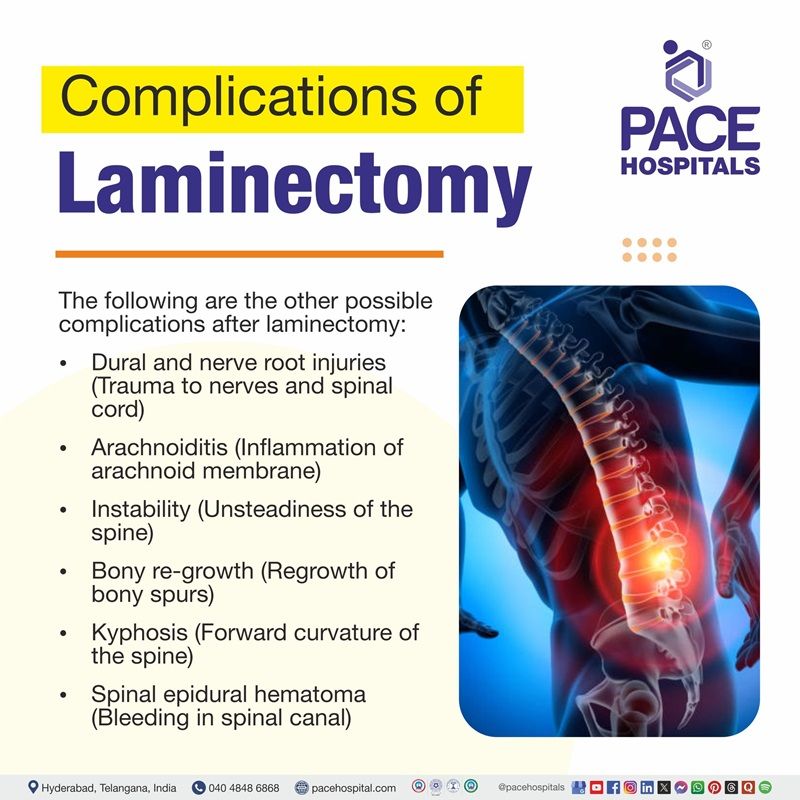
Laminectomy complications
Every surgical procedure has benefits and complications. As with any surgery, laminectomy also has some complications. However, they are rare and include the following:
General complications of any surgery
The possible general complications of any surgery may include the following:
- Bleeding
- Infection of the surgical site
- Allergic reaction to medications, materials, or equipment
- Chest infection
- Scarring
Possible complications of laminectomy surgery
The following are the other possible complications after laminectomy:
- Dural and nerve root injuries: Mechanical damage to the nerves and the covering of the spinal cord (dura)
- Arachnoiditis: Inflammation of the spinal cord membrane (arachnoid mater)
- Instability: Abnormal mobility or loss of spinal stability
- Bony re-growth: Abnormal bone growth in the spine
- Kyphosis: Forward curvature of the spine
- Spinal epidural hematoma: Accumulation of blood in the epidural space
- CSF (cerebrospinal fluid) leak from dural sac tear: Leakage of cerebrospinal fluid due to a tear
- Cerebellar haemorrhage (rare): Bleeding in the cerebellum
- Epidural abscesses: Accumulation of pus in the spinal epidural space.
Life after laminectomy surgery
Laminectomy allows sufficient and safe decompression (pressure relief) of the spinal canal in patients with spinal stenosis, which is a condition where the canal becomes narrow. This procedure is safe and effective in improving symptoms, disability, and enhancing the quality of life for patients. After undergoing laminectomy surgery, the majority of patients experienced few complications.
Questions that the patients can ask the healthcare team about discectomy surgery?
- What are the wound care instructions for my incision site?
- How soon should I contact the healthcare team if I notice any unusual symptoms or issues after the procedure?
- What signs of complications or infections should I watch for at the surgical site?
- When can I go back to my normal activities?
- Are there any specific activities I should avoid during my recovery period?
- What dietary restrictions should I follow during recovery?
- When should I schedule follow-up appointments?
- Will any tests or evaluations be required after the surgery?
Difference between laminectomy and discectomy
Laminectomy vs Discectomy
Laminectomy and discectomy are two spinal surgical procedures that may be performed to relieve pressure on the spinal cord and nerves. Although these are similar, they have some differences, and they address different issues, which include:
| Elements | Laminectomy | Discectomy |
|---|---|---|
| Procedure | It is a surgical removal of the lamina (bony plate) to relieve the compression of the nerves. | It is a surgical removal of the herniated or damaged disc material to relieve nerve compression. |
| Targeted areas | Problems with the back of the vertebrae. | Problems related to vertebral discs. |
| Mainly focuses | To remove a partial or complete lamina to create space for nerves for relieving compression. | To remove the herniated or damaged disc material to relieve nerve compression. |
| Purpose | To relieve pressure on the spinal cord or spinal nerves, remove herniated discs, narrow the canal, or remove tumours. | To treat the herniated, bulging, or prolapsed discs causing constant radicular pain, weakness, or numbness. |
| Indications | Nerve root compression, tumors, severe persistent neck pain, low back pain, arthritis of the spine, and spinal stenosis. | Severe radiating pain, constant (persistent) muscle weakness, difficulty walking, loss of bladder or bowel control. |
| Complications | Instability, bony-re growth, kyphosis, arachnoiditis, epidural abscesses and breakdown of the wound. | Large vessel wounds, epidural bleeding, recurrence of discal herniation, and neurologic complications. |
Difference between Laminotomy and Laminectomy
Laminotomy vs Laminectomy
Laminectomy and laminotomy both are the spinal surgeries where the surgeon removes part or most of the spinal bone (lamina) to create enough space in the spinal column for reducing pressure on nerves. Although these are similar, they have some differences, and they may perform alone or combination with other procedures, the differences may include:
| Elements | Laminotomy | Laminectomy |
|---|---|---|
| It is the process of surgically making a hole in the lamina to remove a small piece of the bone | It is the surgical removal (partially or completely) of the lamina. | |
| Incision | Smaller incision compared to laminectomy (less invasive than laminectomy) | Larger incision compared to laminotomy (because, lamina may be totally removed) |
| Damage | Less damage to muscles around the bone | More damage to muscles around the bone |
| Scope | Remove only smaller portion of lamina to access spine | Removes complete lamina bone to provide more access |
| Stability | Better vertebral stability | Lesser vertebral stability |
| Recovery time | Shorter recovery due to less tissue removal | Longer recovery time due to more tissue removal |
Difference between Fusion and Laminectomy
Spinal Fusion vs Laminectomy
Spinal fusion and laminectomy are both used to address the various issues in the spine, to provide pain relief, and to increase stability issues; the differences may include as follows:
| Elements | Fusion | Laminectomy |
|---|---|---|
| Procedure | It is a surgical technique that involves permanently joining two or more vertebrae together. | It is a surgical removal of the lamina (bony structure) to relieve the compression of the nerves. |
| Indications | Tumor, infection or fracture in the spinal column, scoliosis, spinal stenosis, degenerative disc disease, spondylolisthesis, fractured vertebrae, and herniated disc. | Nerve root compression, tumors, severe persistent neck pain, low back pain, arthritis of the spine, and spinal stenosis. |
| Mainly focuses | To correct problems with small bones in the vertebrae of the spine. | To remove a partial or complete lamina to create space for nerves for relieving compression |
| Purpose | To fuse together two or more vertebrae to heal them into a solid bone and eliminate painful motion or restore spine stability. | To relieve pressure on the spinal cord or spinal nerves, remove herniated discs, narrow the canal, or remove tumours. |
| Complications | Recurring symptoms infection, pseudarthrosis, pain at the graft site, and blood clots | Instability, bony-re growth, kyphosis, arachnoiditis, epidural abscesses and breakdown of the wound. |
Differences between Laminectomy and Laminoplasty
Laminectomy vs Laminoplasty
Laminectomy and laminoplasty are two spinal surgical procedures that may be performed to relieve pressure on the spinal cord and the nerves. Although these are similar, they have some differences, that includes
| Elements | Laminectomy | Laminoplasty |
|---|---|---|
| Procedure | It is a surgical removal of the lamina (bony plate), bony roof, over the spinal cord to relieve the compression of the nerves. | It is a surgical procedure of creating a hinge or gap on the side of the lamina rather than entirely removing it to make more space for the spinal cord without loss of bone. |
| Mainly focuses | To remove entire lamina | Preserving the lamina and creating a gap or hinge |
| Preservation | Lamina is removed, not preserved | Lamina is wholly or partially preserved. |
| Purpose | To relieve pressure on the spinal cord or spinal nerves, remove herniated discs, narrow the canal, or remove tumors. | To relieve pressure on the nerves and spinal cord to increase the space while preserving the motion in the neck. |
| Indications | Nerve root compression, tumors, severe persistent neck pain, low back pain, herniated discs, arthritis of the spine, and spinal stenosis. | Most common treatment for cervical spondylotic myelopathy or multilevel stenosis |
| Recovery time | Longer recovery time | Shorter recovery time compared to laminectomy |
Book an Appointment at PACE Hospitals
Get relief from chronic back pain with expert laminectomy surgery in Hyderabad at PACE Hospitals. Consult our top spine surgeons today!
Frequently Asked Questions (FAQs) on Laminectomy Surgery
Who Needs Laminectomy Surgery?
Laminectomy surgery may be recommended for individuals experiencing the following conditions that haven't responded to non-surgical treatments like physical therapy and medication:
- Chronic back or leg pain caused by spinal compression.
- Difficulty walking or standing for extended periods.
- Nerve-related symptoms such as numbness, tingling, or weakness in the arms or legs.
Is it possible to get rid of the back pain and other symptoms completely after laminectomy?
Yes, the majority of patients who undergo laminectomy do experience relief in their back pain and other symptoms. However, the results are not the same for everyone, and the complete eradication of symptoms may depend on several factors, such as age, overall health, extent of spinal damage, and post-operative care.
Does laminectomy weaken the spine?
No, laminectomy doesn't weaken the spine because, during the procedure, the surgeon carefully removes the lamina (bone) from the spine to decompress the spinal canal. Care is taken to preserve essential structures of the spine to maintain stability to the spine. However, in rare cases, vital structures of the bone may fracture during surgery or afterward, which may cause spinal instability.
Is a laminectomy a major surgery?
Yes, a laminectomy is considered a major surgery as it involves the removal of part of the lamina (spinal bone) to relieve pressure on the spinal cord. However, a few minimally invasive surgical approaches are less major than open surgery in terms of hospital stay, recovery, and incision size. Due to the delicate nature of the spine and spinal cord, the patient must strictly follow the instructions given by the surgeon to recover and heal fast.
Are there any alternatives to a laminectomy?
Yes, there are a variety of methods available as an alternative to a laminectomy, which is used for decompression (relieving pressure). They may include targeted laminotomy, conventional laminectomy, and minimally invasive techniques. Other less invasive interventions that may help with back symptoms include a pain management program, a spinal cord stimulator, a neurotomy, and an intrathecal pain pump.
Is laminectomy safe?
Yes, laminectomy is generally safe. However, as with any surgery, complications may occur. One may experience the following complications such as bleeding, infection at the surgical site, allergic reaction to the medications, materials, or equipment, scarring.
What is post-laminectomy pain syndrome?
Post laminectomy syndrome (PLS) or failed back surgery syndrome (FBSS) is a condition where the patient continues to feel pain after undergoing laminectomy or other spinal surgeries. This syndrome is a significant cause of chronic back pain, which may lead to disability, decreased quality of life, and psychological disorders (such as anxiety & depression). Some patients may experience pain in the lumbar region due to re-herniation (herniated discs) after laminectomy.
Is laminectomy surgery the same as a discectomy?
No, laminectomy is not the same as a discectomy, but both are decompression surgeries of the spine. In laminectomy, the surgeon removes the lamina (section of bone) to relieve pressure on the affected nerve. In diskectomy, a section of the damaged disc is removed to ease pressure. A surgeon may perform discectomy surgery during the laminectomy.
What is a laminectomy back surgery?
Laminectomy back surgery is the surgical removal of all or part of the lamina (partial or complete) to create more space for the compressed spinal cord or nerve roots. It is mainly performed to treat the symptoms of spinal stenosis (narrowing of the spinal canal).
How soon after laminectomy can I exercise?
One may continue with gentle exercises after discharge. The physiotherapist will recommend the appropriate exercises after laminectomy; however, the exercise types and duration may depend on the patient's condition. One should avoid bending, twisting the back, heavy lifting, or moving objects. Avoiding swimming until three weeks after surgery is recommended to allow the wound to heal.
Why is laminectomy done?
Laminectomy is performed when the spinal cord or the nerves of the spine compress and cause symptoms such as pain, numbness, tingling, and weakness that continue despite medical treatment (non-surgical treatments).
The surgeon first investigates the cause of the pressure on the spinal cord and also examines the muscle strength, spine, reflexes, and sense of feeling before deciding whether to perform the laminectomy.
What is a laminectomy foraminotomy?
Laminectomy and foraminotomy are both spinal surgeries that are performed to relieve pressure on compressed nerves. In laminectomy, the surgeon removes the lamina to reduce pressure on the affected nerve.
Whereas in foraminotomy, the surgeon re-opens the intervertebral foramen (nerves of the spine enter and exit the spinal canal through the specialised gaps called foramina) to remove the blockages if present or to allow surgical treatment. A laminoforaminotomy is often performed at the same time as a laminotomy or laminectomy. The combination of these procedures is called a laminoforaminotomy.
Is there entire disk removal in laminectomy?
No, the surgeon may not remove the entire disc in laminectomy. In the laminectomy, the surgeon removes a portion or complete lamina (bone) just over the nerve root. However, in some conditions, the surgeon may perform additional procedures (such as discectomy) to remove or trim disc material underneath the nerve root to create more space and also to address disc-related problems.
Can a laminectomy help numbness & tingling?
Yes, a laminectomy can help to address numbness and tingling. Usually, this procedure is used to reduce the symptoms, such as back (lumbar) or neck (cervical) pain that continues after conservative treatments, or it is also performed when the symptoms of nerve damage, such as numbness, tingling, or weakness in the arms or legs.
Does the bone grow back after a laminectomy?
Yes, the bone can grow back after a laminectomy or laminotomy, especially in the lower back (lumbar spine). However, this regrowth of the bone is less strong than the original one (bone before laminectomy).
Usually, this growth occurs in certain areas, such as the facets and vertebral laminae, but it doesn't completely cover the original bone area. The rate of bone regrowth may increase with the spinal fusion procedures and in cases of increased vertebral instability.
What should you avoid after a laminectomy?
After laminectomy, avoiding activities that strain the spine is recommended, including sitting or standing for too long, bending or twisting at the waist, flexing the spine, climbing too many stairs, going for long trips in the car, lifting over 10 pounds, engaging in sports, aerobic, or cardio activities, strenuous and jarring activities.



